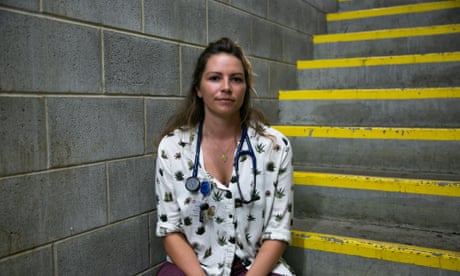- by foxnews
- 03 Apr 2025
‘It was weirdly functional’: the inside story of the extraordinary evacuation of Ballina hospital
‘It was weirdly functional’: the inside story of the extraordinary evacuation of Ballina hospital
- by theguardian
- 12 Mar 2022
- in news

As darkness descended on the northern rivers town of Ballina, a ragtag fleet of taxis, trucks and school buses began pulling up outside the town's small hospital, ready to take part in an extraordinary mission.
The 55-odd patients inside were at risk.
Floods were inundating the northern rivers, and authorities believed the Richmond River would burst its banks, swelled by the basin's unprecedented saturation and a looming high tide.
The order was issued at 6pm on 1 March: the entire hospital was to be evacuated to a local high school, Xavier Catholic College in nearby Skennars Head.
It meant moving palliative care patients, dementia sufferers, the immobile and stroke victims.
Staff were given three hours to prepare.
Among the three doctors on shift was Dr Katie Treble. The past 24 hours had sharpened her resolve.
Treble, along with her dog, Jeff Bridges, had spent the previous day stuck on the roof of her inundated home in low-lying Mullumbimby.
"I thought 'no one predicted what happened in Mullum yesterday, and I've lost all my stuff, my house is under water and my car's gone, so I'm not going to take any chances'," she says. "There was no way I was having my patients go through what we went through."
The complexity of dismantling an entire hospital and setting it up again - at a school, of all places - in three hours is mind-boggling.
Here, staff had to do it in the middle of a flood disaster, in the dark, knowing they might be overwhelmed by patients in coming days.
Treble still isn't sure who organised the vehicles.
But they began to arrive at the hospital in numbers. So did the State Emergency Service, which offered to help however it could.
School buses were used for patients who could walk. The hospital's sickest were transported via ambulance.
Taxis, trucks and SES vehicles were used to transport ultrasound gear, trolleys, air mattresses, huge stocks of medicines, bags of fluid, and airway equipment.
Some patients were incredibly difficult to move.
"A lot of them are confused, don't understand what is going on, and a lot of them are pretty bed-bound too," Treble says.
Xavier College's hall was transformed into a general ward using a sea of inflatable mattresses, each with an IV pole and stand.
Taped to the end of each bed was a piece of A4 paper, recording a number and name for each patient.
Monitors were run from batteries, and staff, lacking a usable IT system, converted all electronic records to paper form.
A classroom was set up as the triage area for new patients, where a nurse waited for arrivals, standing in front of a two-by-two-metre screen, designed to give some semblance of privacy.
The classroom whiteboards were used to track patients and outstanding jobs and orders.
"It had the opportunity to be just a terrible shit-show, and it was the opposite," Treble says. "It was slick and the communication between the team was good, I think everybody understood what role they had and the attitude of everybody was very much 'can-do' and 'how do I help?'."
Another classroom was used as a resuscitation area. A GP clinic and mental health unit were set up in other parts of the school.
Soon, the volunteers began to arrive. Doctors, nurses and hospital staff turned up in uniform, unpaid and unexpected, after hearing of the evacuation.
Many, including emergency doctor Shaska Khosa, were arriving from extraordinary situations of their own.
A day earlier, Khosa, who lives in Brunswick Heads, had launched a boat from a flooded street with her partner, Tom Lee Lewes, and joined a convoy of police rescue and surf lifesaving vessels to Mullumbimby.
"We were just grabbing people from their houses and taking them up to slightly higher ground," she says.
Khosa arrived at the high school at 2am one morning, expecting to stay for six hours to help. She worked a 14-hour shift.
There was no phone signal, she says, and some of the usual services a hospital relies on - including pathology - were nonexistent.
The flood disaster had cut off access to other regional medical centres, leading to an influx to the high school.
Somehow, though, the hospital worked.
Both Khosa and Treble say no patient they dealt with lost any quality of care during the move, an incredible feat amid the unfolding disaster.
"It was weirdly functional, and I think it's because emergency staff are used to working in the face of adversity," Khosa says. "You just very much worked around it, you went back to basic clinical skills: you don't have a chest X-ray, you're going to be listening to their lungs and you've got an ultrasound machine."
Later that week, when the flood threat eased, patients were returned to Ballina hospital.
The evacuation, like so much of what's occurred in the northern rivers, was unprecedented.
"I don't think I've ever heard of anyone having to evacuate a hospital in three hours," Treble says. "I've never heard of it, not in the developed world, anyway.
"But we had an amazing team."
- by foxnews
- descember 09, 2016
Flight passenger says man deliberately squatted in window seat, ignites social media debate
An airline flyer said a seat squatter tried to tell her to swap seats with him, but she stood her ground, prompting a social media debate. A travel expert weighs in.
read more


